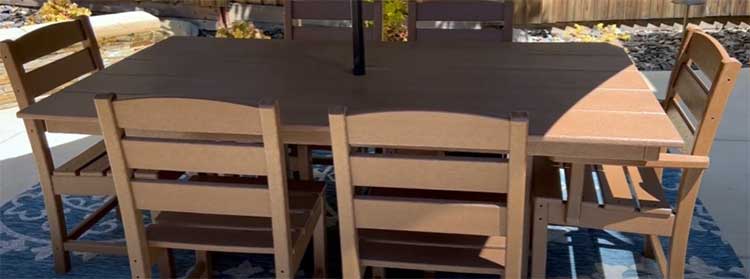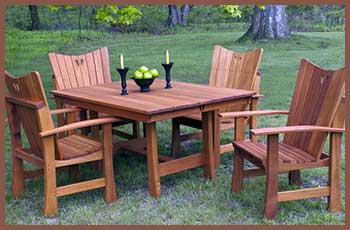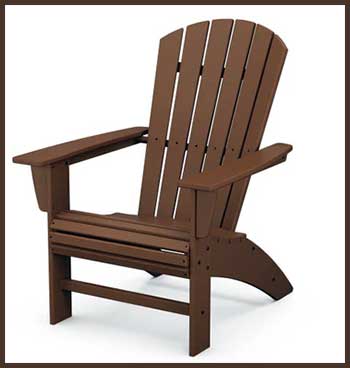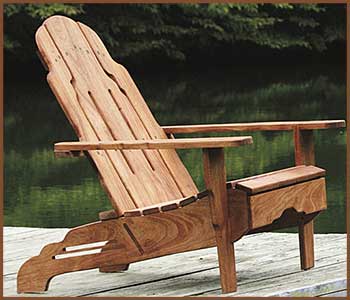I’ve always been drawn to the warmth and beauty of outdoor furniture, the kind that transforms a backyard into a cozy retreat.
When I set out to choose between POLYWOOD Teak, Teak, and Mahogany for my patio, I wanted materials that could withstand the elements while looking stunning.
This article is my exploration of these options, weighing their pros and cons to help you decide what’s best for your outdoor space. From durability to aesthetics, I’ll share my insights to guide you in creating a backyard oasis that lasts.
A Brief Comparison Table
| Feature | POLYWOOD Teak | Teak | Mahogany |
| Material | Recycled HDPE plastic | Tropical hardwood | Tropical hardwood |
| Durability | Extremely durable, weather-resistant | Highly durable, naturally weather-resistant | Durable, less weather-resistant |
| Maintenance | Low; soap and water cleaning | Low; optional oiling | High; requires sealing, sanding |
| Aesthetic | Mimics teak’s golden-brown hue | Golden-brown, ages to silver-gray | Rich reddish-brown, elegant grain |
| Cost | Moderate | Expensive | Moderate to high |
| Eco-Friendliness | Made from recycled materials | Plantation-grown, varies by source | Plantation-grown, varies by source |
| Weight | Lightweight | Heavy | Medium to heavy |
| Weather Resistance | Excellent; resists moisture, UV, pests | Excellent; natural oils protect | Moderate; needs protective coatings |
| Lifespan | 15–20 years | 50+ years | 20–40 years |
My Journey Into Outdoor Furniture Choices
When I first started shopping for outdoor furniture, I pictured lazy summer evenings on my patio, sipping iced tea, surrounded by pieces that felt both luxurious and practical.
I stumbled across POLYWOOD Teak, a synthetic material mimicking real teak, and compared it to the classic hardwoods—teak and mahogany. Each had its charm, but I needed to understand their differences to make the right choice for my space.
My goal was simple: find furniture that could handle rain, sun, and the occasional spilled drink while still looking like it belonged in a magazine.
Understanding POLYWOOD Teak

POLYWOOD Teak caught my attention because it’s not wood at all—it’s high-density polyethylene (HDPE), a type of recycled plastic crafted to look like teak. I was skeptical at first. Plastic furniture? That sounded like the flimsy lawn chairs from my childhood.
But POLYWOOD is different. It’s sturdy, eco-friendly, and designed to mimic teak’s golden-brown glow. I loved the idea of recycled materials—milk jugs and shampoo bottles transformed into a sleek Adirondack chair felt like a win for both my patio and the planet.
The texture of POLYWOOD Teak surprised me. It’s smooth yet substantial, with a grain-like finish that’s convincing from a distance.
I ran my hand over a POLYWOOD chair at a local showroom, and while it didn’t have the warm, organic feel of real wood, it didn’t scream “plastic” either. Its weight is another plus—it’s lighter than real teak, making it easy to rearrange my patio setup when I’m feeling spontaneous.
Exploring Real Teak
Teak, on the other hand, is the gold standard of outdoor hardwoods. Native to Southeast Asia, this tropical hardwood has been used for centuries in shipbuilding and furniture.
When I saw a teak bench at a friend’s house, I was struck by its rich, honeyed hue and subtle grain. It felt alive, like it carried stories from tropical forests. Teak’s natural oils make it a powerhouse against moisture, pests, and decay, which is why it’s a favorite for outdoor settings.
What I love about teak is its aging process. Over time, it weathers to a silvery-gray patina that’s undeniably elegant. I imagined my patio with a teak dining set, gracefully aging as my family grew.
But teak’s heft surprised me—it’s heavy, which is great for stability but a hassle if you’re rearranging furniture often. And the price? Let’s just say my wallet winced when I saw the tag.
Discovering Mahogany’s Charm

Mahogany, another tropical hardwood, has a different kind of allure.
Its deep reddish-brown color and fine grain give it a luxurious, almost regal vibe.
I saw a mahogany rocking chair at an antique store, and its warm tones felt like an invitation to sit and stay awhile.
Mahogany is often used for indoor furniture, but with proper care, it can work outdoors too. It’s less dense than teak, which makes it slightly easier to move, but it lacks the natural oils that give teak its edge in harsh weather.
I learned that mahogany requires more TLC than teak. Without regular sealing or staining, it can fade or crack under the sun’s relentless rays.
But when polished, mahogany’s grain pops in a way that’s hard to resist. It’s like the wood is showing off, demanding attention in any outdoor space.
Pros And Cons of POLYWOOD Teak
Let’s break down what makes POLYWOOD Teak stand out—and where it falls short.
Pros of POLYWOOD Teak

- Durability: This stuff is tough. POLYWOOD resists moisture, UV rays, and insects without breaking a sweat. I left a POLYWOOD chair outside during a stormy week, and it looked untouched afterward.
- Low Maintenance: A quick scrub with soap and water keeps it looking fresh. No sanding, no staining, no fuss. As someone with a busy schedule, I appreciate anything that doesn’t add to my to-do list.
- Eco-Friendly: Made from recycled HDPE, POLYWOOD is a guilt-free choice. Knowing my furniture helps reduce plastic waste feels good.
- Affordability: Compared to real teak, POLYWOOD is a budget-friendly option. I could furnish my entire patio without needing a second mortgage.
- Lightweight: Moving POLYWOOD furniture is a breeze, which is great for someone like me who loves redecorating on a whim.
- Color Options: POLYWOOD comes in various shades, from teak-like tones to vibrant reds. I could match my patio’s vibe without compromising durability.
Cons of POLYWOOD Teak
- Synthetic Look: Up close, you can tell it’s not real wood. For someone who loves the organic feel of hardwood, this was a slight letdown.
- Limited Lifespan: While durable, POLYWOOD typically lasts 15–20 years, which is shorter than teak’s potential century-long lifespan.
- Heat Retention: In scorching summers, POLYWOOD can get hot to the touch. I learned this the hard way after sitting on a sun-baked chair.
- Less Prestige: Let’s be honest—POLYWOOD doesn’t have the same cachet as real teak or mahogany. It’s practical, but it won’t impress woodworking purists.
Pros And Cons of Teak
Teak is the heavyweight champion of outdoor woods, but it’s not perfect. Here’s what I found.
Pros of Teak
- Unmatched Durability: Teak’s natural oils make it nearly indestructible against weather, pests, and rot. I read about teak furniture lasting decades, even in coastal climates.
- Stunning Aesthetic: That golden-brown hue, with its straight or slightly wavy grain, is timeless. Teak furniture feels like an investment in beauty.
- Low Maintenance: You can let teak weather naturally to a silver-gray patina or oil it to maintain its original color. Either way, it’s low-effort compared to other woods.
- Longevity: Teak can last 50 years or more with minimal care. I saw a teak bench at a park that looked pristine after decades of use.
- Versatility: Teak works indoors and outdoors, from patio sets to yacht decks. Its versatility makes it a dream material.
Cons of Teak
- High Cost: Teak is pricey. A single teak chair could cost as much as an entire POLYWOOD set. My budget groaned at the thought.
- Heavy Weight: Teak is dense and heavy, which is great for stability but a pain if you’re moving furniture around.
- Sustainability Concerns: While plantation-grown teak is common, sourcing matters. I worried about the environmental impact of non-certified teak.
- Aging Patina: Not everyone loves the silver-gray look teak develops over time. If you prefer the original color, you’ll need to oil it regularly.
Pros and Cons of Mahogany
Mahogany has its own fanbase, but it comes with caveats. Here’s my take.
Pros of Mahogany

- Gorgeous Appearance: Mahogany’s rich, reddish-brown color and intricate grain make it a showstopper. It’s perfect for creating a sophisticated outdoor vibe.
- Workability: Mahogany is easier to carve and shape than teak, which is great for custom designs. I admired a mahogany table with intricate details that teak couldn’t match.
- Durability: While not as robust as teak, mahogany holds up well with proper care, lasting up to 40 years outdoors.
- Moderate Cost: Mahogany is generally cheaper than teak, making it a more accessible hardwood option.
Cons of Mahogany
- High Maintenance: Mahogany needs regular sealing, sanding, and staining to withstand outdoor conditions. I wasn’t thrilled about the upkeep.
- Less Weather Resistance: Without protective coatings, mahogany can warp or fade in harsh weather. It’s not ideal for exposed patios.
- Sustainability Issues: Like teak, mahogany’s sourcing is critical. Overharvesting has made it scarce, and I wanted to ensure ethical sourcing.
- Insect Vulnerability: Mahogany is less pest-resistant than teak, especially to borers. I’d need to keep an eye out for damage.
Comparing Durability and Weather Resistance
Durability is a big deal for outdoor furniture, especially if you live in a place with unpredictable weather like I do. POLYWOOD Teak shines here. Its HDPE construction laughs off rain, snow, and UV rays.
I tested a POLYWOOD table through a humid summer, and it didn’t warp or fade. Teak is a close second, with its natural oils acting like a built-in shield against moisture and pests. I read about teak furniture surviving decades in coastal areas, which is impressive.
Mahogany, while durable, needs extra protection. Without sealants, it can crack or fade, especially in direct sunlight.
Weather resistance follows a similar pattern. POLYWOOD Teak is virtually impervious to the elements, making it ideal for year-round outdoor use. Teak handles wet and cold climates like a champ, thanks to its oily composition.
Mahogany, however, struggles in harsh conditions unless treated regularly. I imagined leaving a mahogany chair outside during a rainy season—it wouldn’t fare as well as teak or POLYWOOD.
Maintenance: Keeping Your Furniture Looking Great
I’m not one for high-maintenance furniture. POLYWOOD Teak is a dream in this regard—just a quick wash with soapy water, and it’s good as new. I tried this on a POLYWOOD bench, and it took less than 10 minutes. Teak is almost as easy.
You can let it age naturally to a silver-gray patina or oil it occasionally to preserve its golden hue. I found oiling teak to be a relaxing weekend project, but it’s not mandatory.
Mahogany, however, is a different story. It demands regular sealing and staining to maintain its color and prevent damage. I spoke to a friend who owns mahogany furniture, and he spends hours sanding and refinishing every year.
For me, that’s too much work. If you’re like me and prefer low-effort upkeep, POLYWOOD or teak is the way to go.
Aesthetic Appeal: Finding Your Style
Looks matter when it comes to outdoor furniture. POLYWOOD Teak does a great job mimicking teak’s golden-brown tones, but up close, you can tell it’s synthetic.
Still, its clean lines and color options make it versatile. I saw a POLYWOOD set in a vibrant navy that added a fun pop to a friend’s patio.
Teak’s natural beauty is hard to beat. Its warm, golden hue and subtle grain give it a classic, timeless look. I pictured a teak dining table as the centerpiece of my backyard, exuding elegance.
Mahogany, with its rich reddish-brown color and intricate grain, feels more dramatic. It’s perfect if you want a luxurious, almost vintage aesthetic. Ultimately, your choice depends on whether you prefer teak’s understated charm or mahogany’s bold warmth.
Cost and Value: Balancing Budget and Longevity
Budget was a big factor for me. POLYWOOD Teak is the most affordable, with sets often costing half as much as real teak. A POLYWOOD dining set I looked at was around $1,500, while a comparable teak set was closer to $3,000.
Mahogany falls in the middle, with prices varying based on sourcing and quality. A mahogany table I found was about $2,000—more than POLYWOOD but less than teak.
When it comes to value, teak’s longevity makes it a worthwhile investment if you can afford it. POLYWOOD offers great value for the price, especially if you want durability without breaking the bank.
Mahogany’s value depends on your willingness to maintain it—its shorter lifespan and higher upkeep make it less cost-effective over time.
Eco-Friendliness and Sustainability
As someone who cares about the environment, sustainability was a key consideration. POLYWOOD Teak is a standout here, made from recycled HDPE plastic. I felt good knowing my furniture could help reduce landfill waste.
Teak and mahogany, while often plantation-grown, come with caveats. Overharvesting has made both woods scarce in the wild, so I’d only buy from suppliers with certifications like FSC (Forest Stewardship Council). Teak’s slow growth makes sustainable sourcing trickier, while mahogany’s wider availability can still raise ethical concerns if not properly vetted.
Applications: Where Each Material Shines?
POLYWOOD Teak is a jack-of-all-trades, perfect for patio sets, Adirondack chairs, and even poolside loungers. Its lightweight nature makes it ideal for smaller spaces or frequent rearrangements.
I saw a POLYWOOD bench at a café that looked great despite heavy use.
Teak is the go-to for high-end outdoor furniture and marine applications. I drooled over a teak yacht deck online—talk about luxury! It’s also great for dining sets and benches that you want to pass down through generations.
Mahogany shines in indoor settings or sheltered outdoor areas, like covered patios. Its workability makes it ideal for intricate designs, like carved chairs or detailed tables.
My Personal Take: Making the Choice
After weighing all these factors, I leaned toward POLYWOOD Teak for my patio. Its low maintenance, affordability, and eco-friendly credentials won me over. I loved teak’s natural beauty and longevity, but the cost and weight were dealbreakers.
Mahogany’s rich color was tempting, but the upkeep felt like too much for my lifestyle. Your choice might differ—maybe you’re drawn to teak’s timeless elegance or mahogany’s luxurious vibe.
Consider your budget, maintenance preferences, and aesthetic goals to find the perfect fit for your outdoor space.
Frequently Asked Questions (FAQ)
Teak is generally better for outdoor use due to its superior durability and low maintenance, thanks to natural oils. Mahogany is stunning but requires more care and is less weather-resistant.
Teak offers unmatched natural beauty and longevity (50+ years), but POLYWOOD is more affordable, low-maintenance, and eco-friendly, making it better for budget-conscious buyers.
POLYWOOD excels in low maintenance and weather resistance, but real wood like teak or mahogany offers a more authentic, luxurious feel. It depends on your priorities.
Teak is typically more expensive than mahogany due to its durability, scarcity, and high demand. Mahogany is a more budget-friendly hardwood option.
Conclusion: Your Perfect Patio Awaits
Choosing between POLYWOOD Teak, teak, and mahogany is about finding what fits your life. I shared my journey to help you weigh durability, maintenance, cost, and aesthetics. Whether you’re dreaming of a low-maintenance POLYWOOD set, a timeless teak masterpiece, or a striking mahogany piece, your outdoor space can reflect your style and needs.
Think about what matters most—longevity, ease of care, or that wow factor—and pick the material that makes your patio feel like home. What’s your next step in creating your backyard oasis?
